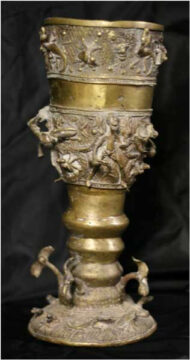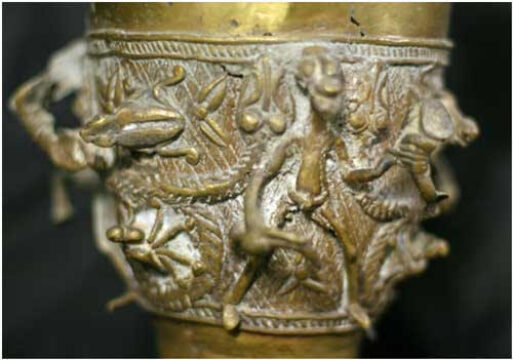The Rosenberg Library Museum showcased a very unique treasure from the Grasslands of Cameroon for January’s Treasure of the Month: a bronze chalice, gifted to the Library by Mr. Gary Goodrich in 1986. This chalice, crafted in the bronze style most attributed to the Benin culture of southwestern Nigeria, prominently features masked individuals, crocodiles, serpents, beetles, lizards, spiders, and birds in high relief with intricate details. It is likely a ceremonial object, and although no date is given, the chalice may be from the late 19th century, which marks the end of the Benin Empire (1897), or earlier.

Because African artwork has slowly gained in popularity, little is known about the development of African metalworks. This makes dating pieces a difficult task, and the possibility for forgery remains high. Intricate testing is needed to examine the patina on a bronze piece before an accurate date can be determined. Microscopic and macro-photographic tests determine wear and damage to the outside surface of the bronze piece by examining layers of corrosion that may have settled on its surface. The Library’s Cameroon bronze chalice features a rich mottled patina, and differences in its textures and thicknesses lend strength to its authenticity of being a genuine Benin bronze artifact.
The Library’s Cameroon bronze chalice may have been cast by craftsmen of the outlying regions of the Benin Empire, an empire that stretched from Nigeria through modern-day Benin and Cameroon. The Benin Empire of southwestern Nigeria flourished between the fifteenth and nineteenth centuries but was first founded in the tenth century AD by the Yoruba peoples, an ethnic and linguistic group first established within the Ife kingdom as early as 500 – 300 BC. Bronze casting was an important element of the Benin Empire for much of its existence and was first introduced in the twelfth century by a cousin empire, the Ife Kingdom. Benin bronzes, often crafted for the oba (king) or for ceremonial purposes, were cast in many forms, like brass heads, free-standing figures, plaques, bells, rattles, masks, jewelry, and battle gear. The technical accomplishment and artistic abilities achieved by the bronze casters of the Benin Empire have long been admired since the bronzes’ introduction to European audiences in the late nineteenth century. Benin-like characteristics of the chalice are its textures, design, and detailed features.
A similar tribe to the Benin Empire, the Bamum Kingdom in central Cameroon, also practiced bronze casting, and the chalice has a few similarities to later Bamum pieces. These similarities exist in stylized animals of various species and background textures on the bronze pieces. Little is known about the development of the Bamum Kingdom, but during the kingdom’s golden age of the 14th century through the late 19th century, the culture developed prestigious sculptures and noteworthy bronze pieces.

Extensive research into the chalice’s origins revealed the distinct rarity of its design. Very few vessels from the Benin or Bamum cultures or similar artistic cultures exist, and goblets or chalices are extremely rare forms. Also, such a vast array of figures within the chalice is a distinctive feature, for most bronze pieces from West Africa focus on singular figures or events. The Rosenberg Library was very excited to share this rare and special treasure with its patrons.